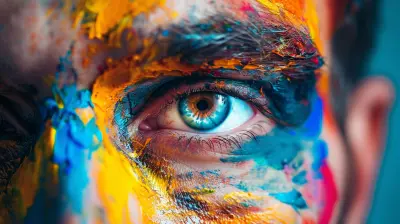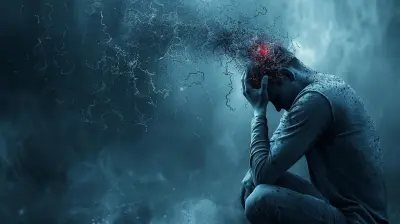The Neuroscience of Love: How Attachment Affects Brain Chemistry
15 June 2025
Love. That one powerful, complicated, magical force that has inspired songs, poems, and even wars. But what if I told you that behind all the butterflies and heart flutters, love has actual roots in brain chemistry? Yep, love isn’t just in the heart—it’s very much in the head too.
If you’ve ever felt addicted to someone’s presence or struggled to let go after a breakup, it’s not just emotion—it’s neuroscience in action. So today, we're diving deep into the science behind love, how attachment styles shape our experiences, and what really happens in our brain when Cupid strikes.
Ready for a small brain adventure with a healthy dose of heart? Let’s go.
Love Isn’t Just a Feeling—It’s a Brain Response
Ever hear someone say, “I’m high on love”? Well, they’re not exaggerating.When we fall in love or feel deeply connected to someone, our brains release a complex cocktail of chemicals—dopamine, oxytocin, serotonin, vasopressin, and even adrenaline. It’s a natural, internal “drug” that makes us feel euphoric, bonded, and yes, occasionally obsessed.
Let’s break down a few of these brain chemicals that play starring roles in love:
- Dopamine: The pleasure neurotransmitter. It surges when something feels good, like eating chocolate or… kissing someone special.
- Oxytocin: Often called the “cuddle hormone,” it’s released during physical touch, especially hugs, sex, and childbirth. It promotes feelings of closeness and trust.
- Serotonin: Regulates mood, and interestingly, serotonin levels actually drop when we fall in love—similar to what happens with obsessive-compulsive disorder.
- Vasopressin: Tied to long-term commitment. It’s especially active after sex and helps create that snug, secure feeling in long-term bonds.
So when we say we’re “in love,” we’re also saying, “My brain is riding a biochemical rollercoaster.”
Attachment Styles: The Brain’s Blueprint for Relationships
Now here’s where it gets even more interesting.The way we experience love—and how our brains react—depends hugely on our attachment style. This isn’t just psychological fluff; it's deeply rooted in early childhood experiences and neural wiring.
1. Secure Attachment
People with a secure attachment style generally have positive views of themselves and others. Their brains release love chemicals in a balanced way. They feel comforted by closeness but are also fine being independent.They’re like the goldilocks of love: not too clingy, not too distant—just right.
2. Anxious Attachment
If you constantly worry your partner will leave you, or you crave reassurance like oxygen, you might have an anxious attachment style. This stems from inconsistent caregiving in early childhood.Your brain’s oxytocin and dopamine systems may be more sensitive—or even over-responsive—making you feel intense highs…and crashing lows.
3. Avoidant Attachment
These folks often feel overwhelmed by emotional closeness. Their brains have learned to protect them by dialing down the chemical response to intimacy. They might not get a strong dopamine hit from connection, which can make love feel like a threat instead of a comfort.4. Disorganized Attachment
This one is a mixed bag. People with disorganized attachment may crave love but fear it at the same time. Their early life experiences often involved trauma or loss, which has distorted the brain’s reward system around love and safety.
How Love Literally Changes the Brain
Love isn’t just a feeling—it’s a neural transformation.MRI scans show that when people look at photos of someone they love, the brain lights up in the ventral tegmental area (VTA), which is part of the reward system. This area is rich in—you guessed it—dopamine.
In long-term relationships, the brain also activates the caudate nucleus, which helps us build trust and form habits. Over time, being with someone becomes more about emotional safety than butterflies. But don’t worry, that’s a good thing.
It’s like switching from the thrill of a rollercoaster to the comfort of your favorite armchair. Both are satisfying. Just in different ways.
Why Breaking Up Hurts (Literally)
Here’s the kicker: love not only activates pleasure centers—it also messes with pain.Studies show that a breakup lights up the same areas of the brain associated with physical pain. That’s why a broken heart can actually feel like a punch to the gut. Crazy, right?
The drop in dopamine and oxytocin during heartbreak is similar to withdrawal from a drug. Which is why you might find yourself replaying old texts or photos—your brain is literally craving that chemical hit.
This also explains rebound relationships, emotional eating, or binge-watching Netflix post-breakup. Your brain is looking for ways to self-soothe, to replace what it’s lost.
So yes, if you’ve ever felt like you’re “addicted” to someone, you technically were.
Oxytocin: The Real MVP of Long-Term Love
While dopamine gets all the attention in the early stages, oxytocin really steals the show in long-term relationships. It promotes bonding, reduces stress, and increases feelings of trust and safety.Think of it as emotional velcro—it keeps people connected.
But here’s the catch: oxytocin is context-sensitive. In a healthy relationship, it encourages love and support. In a toxic one, it can create trauma bonding, making someone feel stuck even when they know they should leave.
So the next time you feel attached to someone, ask yourself—do you feel safe, or just familiar?
Can We “Hack” Our Brain Chemistry for Better Love?
Short answer: Sort of.While we can’t rewire our brains overnight, we can absolutely influence how we attach, bond, and love—starting with awareness.
1. Practice Mindful Love
Slow down. Really notice your emotions around attachment. Are you clinging? Running? Detaching? Your brain is giving you clues to past triggers.The more aware we are of those patterns, the more power we have to shift them.
2. Build Secure Connections
It’s never too late to develop a secure attachment style. Therapists (especially those trained in attachment theory) can help reframe how you view love, safety, and intimacy.Also, being in secure relationships—romantic or platonic—can literally rewire your brain’s emotional circuitry. It’s like emotional muscle memory.
3. Boost Your Natural Love Chemicals
Want to up your oxytocin naturally? Try:- Hugging
- Meaningful eye contact
- Acts of kindness
- Deep conversations
- Laughing with someone
All of these behaviors are like little brain love-pills—no prescription needed.
The Love-Addicted Brain vs. The Emotionally Balanced One
Let’s talk about the “love-drunk” phase. During those first few months of a romance, your brain is saturated with dopamine. This rush can cloud judgment, which is why red flags suddenly look like carnival confetti.But eventually, your brain levels out. That’s when you really see the person—not just the chemical high.
A love-addicted brain craves the chase, the drama, and the highs. But an emotionally balanced brain seeks stability, mutual growth, and support. It’s the difference between a sugar rush and sustained energy.
So ask yourself: is your relationship feeding your brain… or overfeeding your insecurities?
Love and Personal Growth: A Two-Way Street
Here’s a beautiful truth: every healthy relationship is a personal growth journey.The more we understand our attachment style and how our brain responds to love, the more thoughtful and compassionate we become—toward ourselves and our partners.
- Anxious? Practice self-soothing techniques.
- Avoidant? Try leaning into vulnerability.
- Disorganized? Seek out emotionally safe people and environments.
- Secure? Nurture it. It’s a gift.
Love isn’t about being perfect. It’s about being aware.
Final Thoughts: Your Brain on Love Is a Beautiful Work in Progress
At the end of the day, love isn’t a puzzle to solve—it’s a journey to experience. Your brain is doing exactly what it’s designed to do: seek connection, safety, and meaning.Understanding the neuroscience behind love doesn’t take the romance out of it. If anything, it makes it more magical. Because now, when your heart skips a beat, you'll know—it’s not just poetry… it’s biology.
So nurture your brain. Feed it healthy love. Make peace with your past. And remember, you’re wired to love—and be loved—deeply.
all images in this post were generated using AI tools
Category:
NeuroscienceAuthor:

Eliana Burton
Discussion
rate this article
2 comments
Primrose Coleman
This article insightfully examines how attachment shapes brain chemistry, revealing the profound interplay between love and neuroscience. Fascinating!
June 22, 2025 at 3:29 PM

Eliana Burton
Thank you for your thoughtful comment! I'm glad you found the connection between attachment and brain chemistry fascinating.
Alexa James
Understanding the neuroscience of love reveals how our attachments shape brain chemistry, influencing emotional well-being. Nurturing healthy connections can enhance our mental health, making love not just an emotion, but a vital necessity.
June 21, 2025 at 2:41 AM

Eliana Burton
Thank you for your insightful comment! Indeed, the interplay between love, attachment, and brain chemistry is crucial for mental health and well-being. Nurturing these connections is essential for a fulfilling life.


